“Czy stracę pozycję w rankingu Google, jeśli przeniosę bloga?”. To pytanie numer jeden, które słyszymy za każdym razem, gdy ktoś zastanawia się nad przejściem z Bloggera na WordPressa.
Rozumiemy to – ale po tym, jak pomogliśmy niezliczonej liczbie blogerów dokonać tego przejścia, możemy powiedzieć z całą pewnością: przejście z Bloggera na WordPressa jest absolutnie możliwe bez poświęcania twoich rankingów Google.
Z biegiem lat udoskonaliliśmy proces migracji, aby zabezpieczyć twój SEO podczas aktualizacji do bardziej wydajnej platformy blogowej. Dzięki próbom i błędom dowiedzieliśmy się dokładnie, co należy zrobić (a czego unikać!), aby zabezpieczyć twoje ciężko zarobione miejsce w wynikach wyszukiwania Google.
W tym przewodniku przeprowadzimy Cię przez naszą sprawdzoną metodę przejścia z Bloggera na WordPressa. Poznasz te same techniki, których użyliśmy, aby pomóc niezliczonym blogerom, takim jak Ty, ulepszyć ich witryny bez poświęcania ich widoczności w wyszukiwarkach.
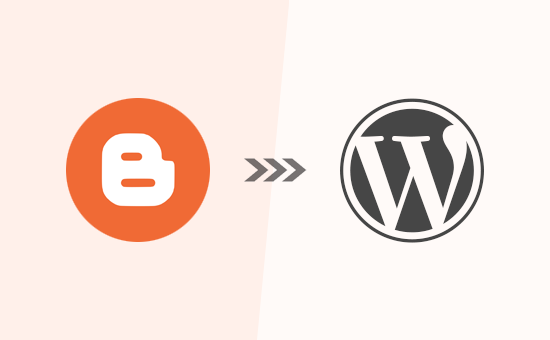
Dlaczego warto przejść z Bloggera na WordPressa?
Obecnie korzystasz z Bloggera, popularnej platformy blogowej stworzonej przez Google, która umożliwia każdemu założenie darmowego bloga za pomocą konta Google.
To świetny punkt wyjścia dla wielu osób, ale wielu początkujących szybko zdaje sobie sprawę, że ich darmowy blog na Bloggerze może wydawać się nieco ograniczony. Może się okazać, że chciałbyś zrobić więcej.
W tym miejscu z pomocą przychodzi WordPress. W przeciwieństwie do Bloggera, WordPress.org daje ci pełną kontrolę nad twoją witryną internetową. Pozwala również na dodanie funkcji niezbędnych do rozwoju twojego bloga i zarabiania pieniędzy w Internecie. A jeśli chodzi o powiadomienie w Google, WordPress.org pozwala wykonać wszystkie ważne modyfikacje SEO, aby poprawić twoje rankingi.
Chcesz uzyskać więcej informacji? Przygotowaliśmy szczegółowe porównanie WordPressa i Bloggera, abyś mógł zobaczyć wszystkie różnice.
Według naszych statystyk badawczych WordPress jest najpopularniejszą platformą witryn internetowych na świecie i obsługuje prawie 43% wszystkich witryn internetowych.
Oznacza to, że wybierając WordPress, dołączasz do milionów innych odnoszących sukcesy witryn internetowych. Wybierasz platformę, której zaufało mnóstwo ludzi i która jest idealna do prezentowania twoich treści.
To powiedziawszy, istnieją dwa rodzaje oprogramowania WordPress, więc ważne jest, aby wybrać odpowiedni.
Pierwszym z nich jest WordPress.com, który jest hostowanym narzędziem do tworzenia witryn internetowych. Dzięki WordPress.com nie musisz szukać własnego planu hostingowego i samodzielnie instalować oprogramowania. Zamiast tego możesz wybrać darmowy plan lub kupić jeden z dostępnych płatnych planów, a Automattic będzie hostować twoją witrynę internetową.
Następnie jest WordPress.org, który jest również znany jako samodzielnie hostowany WordPress. Zawsze zalecamy korzystanie z WordPress.org, ponieważ w przeciwieństwie do WordPress.com, nie musisz płacić za kosztowny plan, aby móc zainstalować wtyczki (pomyśl o nich jak o dodatkach do twojej nowej witryny internetowej WordPress)!
Biorąc to pod uwagę, przyjrzyjmy się, jak prawidłowo przenieść się z Bloggera na WordPressa, zachowując twoje rankingi wyszukiwania Google i ruch w witrynie internetowej.
Oto wszystkie kroki, które omówimy, aby Twoje przejście z Bloggera na WordPress było płynne i przyjazne dla SEO:
- Step 1. Sign up for WordPress Hosting
- Step 2. Export Your Blogger Blog
- Step 3. Import Blogger to WordPress
- Step 4. Setting Up Permalinks
- Step 5. Set Up Redirects From Blogger to WordPress
- Step 6. Moving Other Content From Blogger to WordPress
- Step 7. Things to Do After Migrating From Blogger to WordPress
- Video Tutorial
Gotowy? Zaczynajmy.
Krok 1: Zarejestruj się w WordPress Hosting
Aby rozpocząć korzystanie z WordPressa, potrzebna będzie nazwa domeny i hosting.
Dla krótkiego przypomnienia, nazwa domeny to adres Twojej witryny internetowej, który ludzie wpisują, aby dostać się do Twojego bloga, a hosting to miejsce, w którym przechowywane są pliki Twojej witryny. Oba te elementy są NIEZBĘDNE do stworzenia dowolnego rodzaju bloga lub witryny internetowej.
Mając to na uwadze, zalecamy korzystanie z Bluehost. Jest to jedna z największych firm hostingowych na świecie i oficjalnie rekomendowany partner hostingowy WordPress.
Ponieważ WPBeginner jest największą witryną z zasobami WordPress, zgodzili się zaoferować naszym czytelnikom darmową nazwę domeny i 60% zniżki na hosting. Zasadniczo możesz zacząć za jedyne 1,99 USD miesięcznie.
Jeśli wolisz wybrać alternatywę Bluehost, zalecamy skorzystanie z SiteGround lub Hostinger, ponieważ oba są doskonałymi rozwiązaniami (w rzeczywistości używamy SiteGround do hostowania WPBeginner!).
Po zarejestrowaniu się w planie hostingowym WordPress i skonfigurowaniu twojej nazwy domeny, możesz przejść do kroku instalacji WordPress.
Jeśli zarejestrujesz się w Bluehost za pomocą naszego powyższego odnośnika, WordPress zostanie zainstalowany automatycznie.
Jeśli korzystałeś z usług innego dostawcy hostingu WordPress, musisz zainstalować WordPress, postępując zgodnie z naszym kompletnym przewodnikiem na temat instalacji WordPress.
Po zainstalowaniu WordPressa nadszedł czas, aby przenieść twoje treści z Bloggera do WordPressa.
🧑💻 Słyszeliśmy was głośno i wyraźnie! Ponieważ tak wielu z was pytało, z radością ogłaszamy, że oferujemy teraz całkowicie BEZPŁATNĄ usługę migracji z Bloggera do WordPressa w ramach naszej bezpłatnej konfiguracji bloga WordPress! Zgadza się – jeden z członków naszego zespołu ekspertów zajmie się wszystkim za darmo. Możesz dosłownie przenieść się z Bloggera do potężnego świata WordPress bez żadnych kłopotów i ryzyka.
Nasza bezpłatna usługa migracji z Bloggera jest idealna dla mniejszych blogów z mniej niż 1000 wpisów. Jeśli masz większą witrynę Blogger, nie martw się! Nadal możemy pomóc w migracji, ale będzie to usługa płatna.
Krok 1: Eksport twojego bloga na Bloggerze
Pierwszą rzeczą, którą musisz zrobić, jest wyeksportowanie treści twojego bloga Blogger. Możesz to zrobić, przechodząc na witrynę internetową Blogger i logując się do kokpitu twojego konta.
Następnie przejdź do strony Ustawienia. Przewiń w dół do sekcji “Zarządzaj blogiem” i kliknij przycisk “Utwórz kopię zapasową treści”.
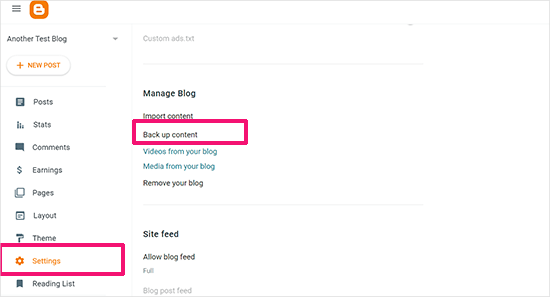
Spowoduje to wyświetlenie wyskakującego okienka pokazującego, co dokładnie zawiera kopia zapasowa Bloggera.
Aby kontynuować, należy kliknąć przycisk “Pobierz”.
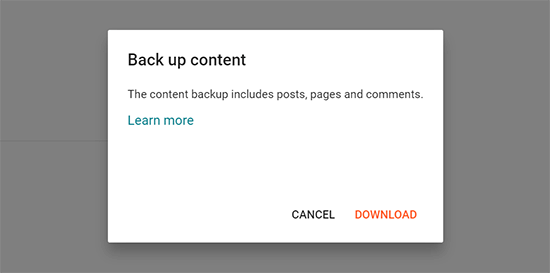
Treść twojego bloga Blogger zostanie pobrana na twój komputer w pliku XML.
Po zakończeniu pobierania, nadszedł czas, aby importować twoją treść z Bloggera do witryny WordPress.
Krok 2: Importowanie Bloggera do WordPressa
Aby rozpocząć importowanie witryny Blogger do WordPress, zaloguj się do obszaru administracyjnego WordPress i przejdź na stronę Narzędzia ” Importuj.
Na stronie importera kliknij odnośnik “Zainstaluj teraz” poniżej Bloggera.
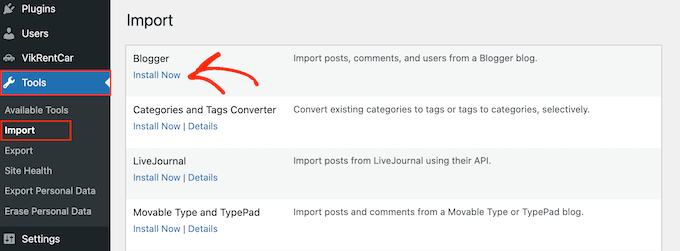
WordPress pobierze i zainstaluje wtyczkę Blogger Importer.
Po zakończeniu instalacji należy kliknąć odnośnik “Run Importer”, aby kontynuować.
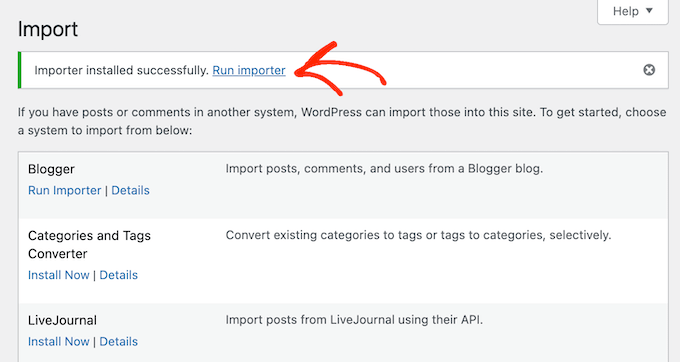
WordPress poprosi o przesłanie pliku XML na ekranie Importuj Bloggera. Jest to plik pobrany w kroku 1.
Wystarczy kliknąć przycisk “Wybierz plik” i przesłać pobrany wcześniej plik XML.
Następnie kliknij przycisk “Prześlij plik i importuj”, aby kontynuować.
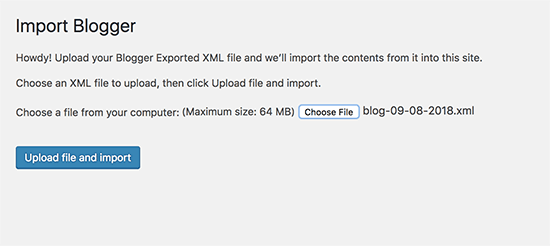
WordPress zaimportuje teraz plik. Jeśli twój plik importu jest zbyt duży, może pojawić się komunikat o błędzie.
W takim przypadku musisz zwiększyć twój maksymalny limit przesyłania plików. Jeśli twój plik jest mały, nie zobaczysz żadnych błędów.
Następnie zostaniesz poproszony o przypisanie wpisów do autora. Jeśli masz wielu autorów na twoim blogu Blogger, możesz utworzyć nowe konto użytkownika dla każdego z nich. Możesz również przypisać te wpisy do istniejących autorów na twojej witrynie internetowej WordPress.
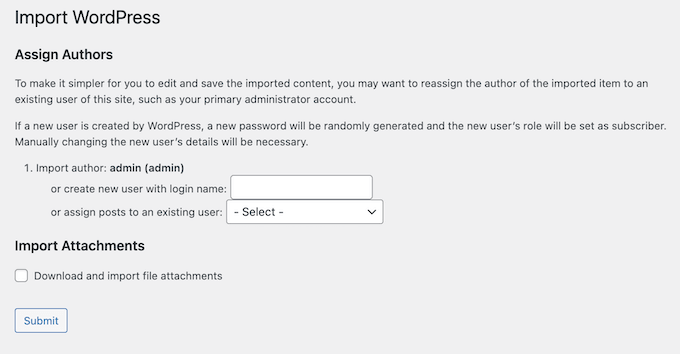
Po dokonaniu twojego wyboru kliknij przycisk “Wyślij”, aby kontynuować.
WordPress zaimportuje całą treść z pliku eksportu Bloggera na twoją witrynę WordPress. Treść można zobaczyć, przechodząc na stronę Wpisy ” Wszystkie wpisy.
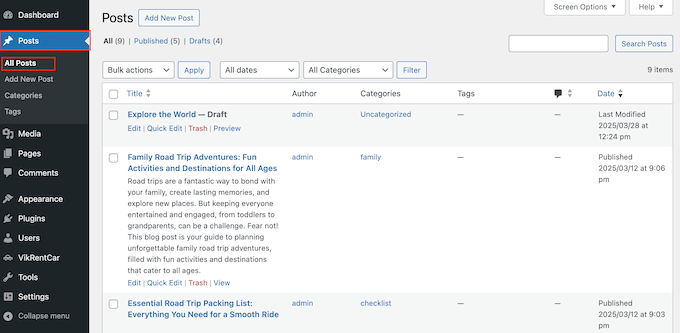
Krok 3: Konfiguracja bezpośrednich odnośników
Bezpośredni odnośnik to taksonomia używana do struktury adresów URL poszczególnych stron. WordPress jest wyposażony w funkcję, która pozwala skonfigurować przyjazną dla SEO strukturę adresów URL.
Ponieważ importujesz treść z Bloggera, struktura adresów URL musi być jak najbardziej zbliżona do struktury adresów URL twojej starej witryny Blogger.
Aby ustawić bezpośrednie odnośniki, musisz przejść do Ustawienia ” Permalinki w twoim kokpicie WordPress i wybrać opcję “Własna struktura”.
Następnie należy dodać następujący tekst w polu obok pola struktury własnej:
1 | /%year%/%monthnum%/%postname%.html |
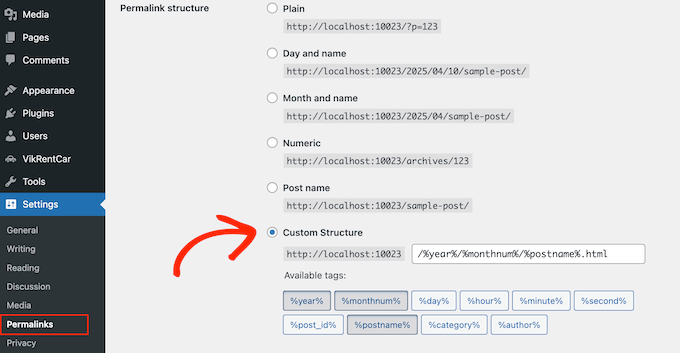
Ta struktura bezpośrednich odnośników sprawia, że adresy URL wpisów na twoim blogu są podobne do adresów URL na starym blogu Blogger.
Czasami jednak adres URL twojego wpisu na blogu, znany również jako slug w WordPressie, nie będzie pasował do slug używanych przez Bloggera.
Aby to poprawić, należy utworzyć i uruchomić mały fragment kodu.
Zalecamy dodanie tego kodu PHP za pomocą wtyczki WPCode. Jest to najbezpieczniejszy sposób na dodanie własnego kodu do twojej witryny internetowej WordPress. Aby uzyskać więcej informacji, zapoznaj się z naszym przewodnikiem na temat kopiowania i wklejania fragmentów kodu w WordPress.
1 2 3 4 5 6 7 8 9 10 11 12 13 14 | add_action( 'init', 'wpb_update_slug' );function wpb_update_slug() {global $wpdb;$result = $wpdb->get_results("SELECT post_id, meta_value FROM $wpdb->postmeta WHERE meta_key = 'blogger_permalink' ");$wpdb->print_error();foreach ($result as $row){$slug = explode("/",$row->meta_value);$slug = explode(".",$slug[3]);$wpdb->query("UPDATE $wpdb->posts SET post_name ='$slug[0]' WHERE ID = '$row->post_id' ");}echo "DONE";} |
Po zapisaniu kodu wystarczy przejść na dowolną stronę w twojej witrynie WordPress, aby uruchomić ten skrypt. Po uruchomieniu skryptu nie zapomnij wyłączyć lub usunąć go z twojej biblioteki WPCode, ponieważ musi on zostać uruchomiony tylko raz.
Krok 4: Konfiguracja przekierowań z Bloggera do WordPressa
Najważniejszym krokiem przy przenoszeniu dowolnej witryny internetowej jest skonfigurowanie odpowiedniego przekierowania, aby nie stracić istniejącego ruchu ani rankingów SEO. Aby uzyskać więcej informacji, zapoznaj się z naszą ostateczną listą kontrolną migracji WordPress SEO.
⚠️ Jeśli Twój blog na Bloggerze ma własną, niestandardową domenę zamiast blogspot.com, może być konieczne wskazanie serwerów nazw domeny dostawcy hostingu. Aby uzyskać instrukcje, postępuj zgodnie z naszym poradnikiem dotyczącym przełączania bloga Blogger z własną domeną na WordPress.
Kluczową częścią przekierowania jest zapewnienie, że twoi użytkownicy wylądują na tej samej stronie w nowej domenie, do której próbowali uzyskać dostęp w starej witrynie.
Jednocześnie musisz również upewnić się, że wyszukiwarki rozumieją, że twoja witryna internetowa została przeniesiona do tej nowej lokalizacji.
W tym celu należy zainstalować i włączyć wtyczkę Blogger to WordPress Redirection. Aby uzyskać więcej informacji, zobacz nasz przewodnik krok po kroku, jak zainstalować wtyczkę WordPress.
Po włączaniu należy przejść na stronę Narzędzia ” Przekierowanie z Bloggera na WordPress i kliknąć przycisk “Rozpocznij konfigurację”.
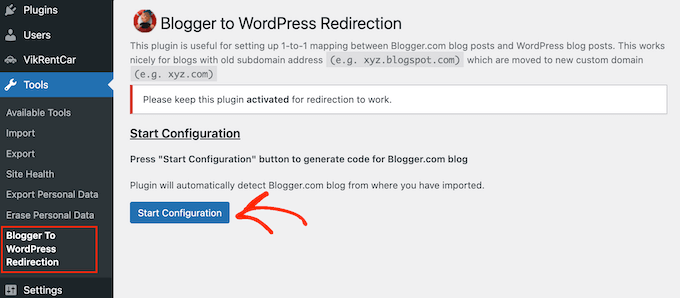
Wtyczka wykryje teraz adres URL twojego bloga na Bloggerze i wyświetli opcję uzyskania kodu przekierowania. Kliknij przycisk “Pobierz kod” obok twojego adresu URL Bloggera.
Wygeneruje on teraz fragment kodu, który będzie potrzebny do prawidłowego przekierowania użytkowników z twojego starego bloga Blogger na nową witrynę WordPress.
Następnie musisz logować się do kokpitu Bloggera i przejść do strony “Motywy”. Kliknij strzałkę rozwijaną na przycisku “Dostosuj” obok twojego motywu, a następnie wybierz opcję “Edytuj HTML”.
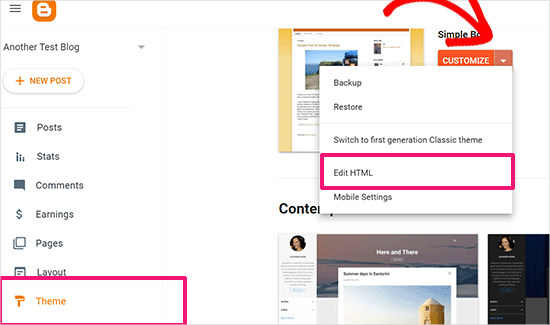
Blogger wyświetli teraz własny kod HTML dla twojego szablonu motywu. Jeśli dokonałeś jakichkolwiek dostosowań w twoim motywie Bloggera, możesz skopiować kod i zapisać go na komputerze jako kopię zapasową.
W przeciwnym razie możesz po prostu usunąć wszystko. Następnie skopiuj kod wyświetlany przez wtyczkę na twojej witrynie WordPress i wklej go do edytora motywu Bloggera.
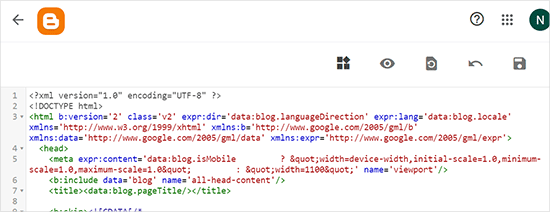
Nie zapomnij kliknąć przycisku “Zapisz motyw”, aby zapisać twoje zmiany.
Następnie musimy skonfigurować przekierowania dla użytkowników mobilnych.
Musisz wrócić do strony Motywy w kokpicie twojego bloga Blogger. Tym razem należy kliknąć przycisk koła zębatego poniżej mobilnego podglądu twojego bloga.
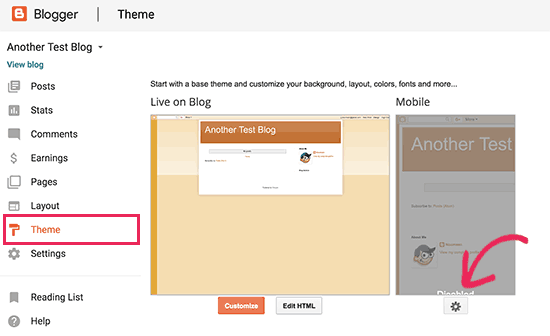
Spowoduje to wyświetlenie wyskakującego okienka, w którym należy wybrać opcję “Nie. Pokaż motyw pulpitu na urządzeniach mobilnych”.
Następnie kliknij przycisk “Zapisz”.
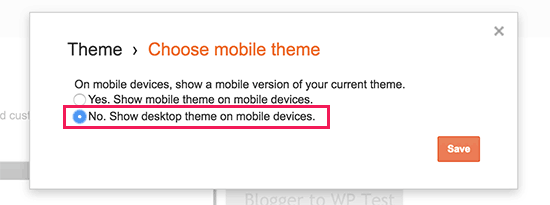
To wszystko, twój blog na Bloggerze będzie teraz przekierowywał wszystkich odwiedzających na twój nowy blog WordPress.
Alternatywnie, można również użyć All in One SEO (AIOSEO) do przekierowania wpisów i stron z Bloggera do WordPressa. Wtyczka oferuje potężną funkcję menedżera przekierowań, która pozwala skonfigurować pełne przekierowania witryny na twoją nową witrynę.

Ponadto możesz włączyć śledzenie błędów 404 i wychwycić wszelkie niedziałające odnośniki, które mogą wystąpić podczas przenoszenia twojej witryny do WordPress. Pomoże to poprawić komfort użytkowania i nie stracić pozycji w rankingach słów kluczowych.
Używamy AIOSEO do zarządzania wszystkimi naszymi stronami i wpisami na WPBeginner – i szczerze? Jesteśmy zachwyceni wynikami. Dlatego jest to nasza rekomendacja dla wszystkich.
Aby dowiedzieć się więcej o naszych doświadczeniach, sprawdź naszą szczegółową recenzję AIOSEO.
Krok 5: Przenoszenie treści z Bloggera do WordPressa
W tym kroku przeniesiemy pozostałą treść ze starego bloga na Bloggerze na twój nowy blog WordPress. Może to wymagać trochę ręcznej pracy, w zależności od ustawień/treści twojego bloga.
1. Przenoszenie stron z Bloggera do WordPressa
Narzędzie importera Bloggera WordPressa importuje tylko wpisy Bloggera i ignoruje strony.
Aby przenieść twoje strony do WordPressa, będziesz musiał edytować każdą stronę na swoim blogu Blogger, skopiować jej treść, a następnie ręcznie utworzyć stronę w WordPressie.
Aby dowiedzieć się więcej o stronach, zapoznaj się z naszym artykułem na temat różnicy między wpisami a stronami w WordPress.
Teraz natkniesz się na inny problem. Strony Bloggera mają adresy URL, które wyglądają tak:
http://example.blogspot.com/p/about-us.html
Adres URL twojej strony WordPress będzie wyglądał następująco:
http://example.com/about-us
Aby to naprawić, należy użyć wtyczki All in One SEO (AIOSEO). Aby uzyskać instrukcje, zapoznaj się z naszym przewodnikiem dla początkujących na temat tworzenia przekierowań w WordPress.
2. Widżety
Podobnie jak Blogger, niektóre motywy WordPress również wykorzystują widżety do dodawania treści do panelu bocznego twojego bloga.
Aby dodać widżety, musisz przejść na stronę Wygląd ” Widżety w twoim kokpicie WordPress i po prostu przeciągnąć / upuścić widżety na panel boczny. Szczegółowe instrukcje można znaleźć w naszym przewodniku na temat dodawania i używania widżetów w WordPress.
Jeśli szukasz konkretnego widżetu, którego nie widzisz domyślnie w WordPressie, prawdopodobnie potrzebujesz wtyczki WordPress. Możesz przeszukać kategorię najlepszych wtyczek WordPress na WPBeginner, aby znaleźć potrzebną funkcjonalność.
3. Kanały RSS
Wyszukiwarki i użytkownicy, którzy subskrybują wpisy na Twoim blogu za pośrednictwem kanałów RSS, nadal będą mogli znaleźć Twojego bloga. Nie otrzymają jednak żadnych nowych treści.
Aby to naprawić, przejdź na stronę ustawień na twoim koncie Blogger. Następnie przewiń w dół do sekcji “Kanał witryny” i kliknij opcję “Przekieruj adres URL kanału”.
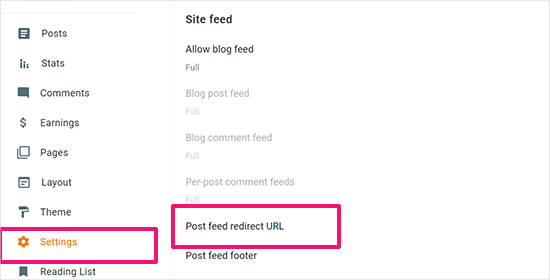
Spowoduje to wyświetlenie wyskakującego okienka, w którym należy dodać adres URL kanału RSS twojej witryny internetowej WordPress.
Twój adres URL kanału WordPress będzie wyglądał następująco:
http://example.com/feed
Nie zapomnij zastąpić example.com twoją własną nazwą domeny.
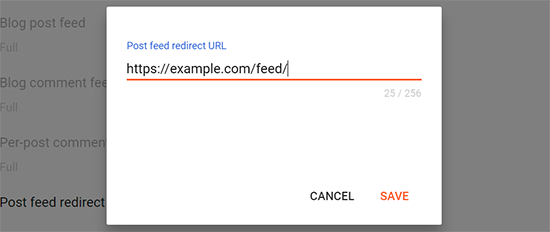
Kliknij przycisk “Zapisz”, aby dodać adres URL i zapisać twoje ustawienia.
Krok 6. Czynności do wykonania po migracji z Bloggera do WordPressa
Teraz, gdy z powodzeniem przeniosłeś swojego bloga z Bloggera na WordPressa, przyjrzyjmy się, co jeszcze możesz zrobić, aby ulepszyć swojego bloga.
Stworzyliśmy listę kontrolną najważniejszych rzeczy, które należy zrobić po zainstalowaniu WordPressa.
WordPress jest dość łatwy w użyciu. Jednak od czasu do czasu odkryjesz nowe rzeczy, z którymi możesz potrzebować pomocy. Tutaj z pomocą przychodzi WPBeginner.
WPBeginner to największa na świecie witryna z darmowymi zasobami dotyczącymi WordPressa. Regularnie publikujemy poradniki i przewodniki napisane specjalnie dla blogerów i małych firm.
Oto niektóre z przydatnych zasób, które można znaleźć na WPBeginner (wszystkie są darmowe):
- Blog WPBeginner – Centralne miejsce dla wszystkich naszych poradników i przewodników WordPress.
- Słownik WPBeginner – Nasz słownik WordPressa to najlepsze miejsce do zapoznania się z WordPressowym żargonem.
- WPBeginner Videos – Nowi użytkownicy WordPressa mogą zacząć od tych filmów krok po kroku, aby opanować WordPressa.
- WPBeginner na YouTube – Potrzebujesz więcej filmowych instrukcji? Subskrybuj nasz kanał YouTube z ponad 291 000 subskrybentów i ponad 50 milionami zobacz.
- WPBeginner Blueprint – Sprawdź wtyczki, narzędzia i usługi, z których korzystamy na WPBeginner.
- WPBeginner Deals – Ekskluzywne zniżki na produkty i usługi WordPress dla użytkowników WPBeginner.
Film instruktażowy
Mamy nadzieję, że ten artykuł pomógł ci w przejściu z Bloggera na WordPressa, nie mając przy tym wpływu na twoje pozycje w wyszukiwarce Google. Możesz również zapoznać się z naszym przewodnikiem po tym, z którego planu WordPress powinieneś skorzystać lub obalić najczęstsze mity dotyczące WordPressa.
If you liked this article, then please subscribe to our YouTube Channel for WordPress video tutorials. You can also find us on Twitter and Facebook.





Mini
This useful even for moving free blog on blogspot to free blog on wordpress?
And will it transfer previously received comments too?
Katheriine
I have a problem with all of my pinterest pins stopping at a blogger page saying “this blog is no longer hosted by blogger do you wish to be redirected?” and you have to choose yes or no and obviously people usually just exit out or hit no so it’s killing my page views. Any help??
Susann
I don’t have the export blog (or import) button on my blogg. Only the Delete button. Did they take this away, how can I export my blog now? Or do I need to change anything somewhere else to get it to show up?
Eli
Hi, I don’t can’t use permalinks with /month/day, i need to use /blog-post-title.
is there a way to modify the php code, to get a proper redirect?
WAHEED HABIB
Dear Author, thank u so much for such a great help in transferring blogger data to wordpress theme. But redirection woud;nt work for me rather i use simple Blogger to WordPress Redirection plugin a very simple and easy to use tool i just love it. I have redirect my blogger site to WordPress.
Mallory
Hi! Thank you so much for this helpful guide!!
I’ve done everything as you explained and redirection works but I get this message on top of my wordpress: Notice: Undefined index: blogger in /var/www/vhost/example/home/html/wp-content/themes/betheme-child/functions.php on line 94
I therefore went and checked line 94 and this is the one: $blogger = $wp_query->query_vars[‘blogger’];
would you be able to help me?
Thank you so much
Patricia
Hi, currently trying to follow your instructions but I keep getting this message when I try to save the blogger redirection code in reference to the blog page title line.
“Error parsing XML, line 3, column 9: The content of elements must consist of well-formed character data or markup.”
Please help?
JC
Glad i found this. I’ve been so afraid to move my blog from blogger to W/P. One question: Do my followers on blogger also go with me?
Also, is there a way (don’t know what it’s called) to let those that come to your blogger site know that you’ve moved to W/P?
WPBeginner Support
If by followers you mean those who used Google ID to follow your blogger blog, then no.
Yes, using this method, people arriving at your blogger site through other sources will be properly redirected to your new site.
Admin
Lindsey
So helpful. However, when I refresh after all the steps, I get the 2nd code we pasted showing at the top. Am I missing something? It is even showing in my WP Admin dashboard!!
WPBeginner Support
It seems you pasted the code after a closing ?> php tag. You can paste the code again before the closing php tag or add this tag at the beginning of the code
<?phpAdmin
Katelyn
I am having the hardest time converting from BlogSpot to Word Press. For some reason I don’t know if it’s the browser I’m using or what but when I go to Settings –> Other —> to import and backup or backup content (those are the only two options it give me) I don’t have an export blog option. I’m getting ready to just freakin pay someone to do it!
Huda
What about the design theme? can I change it to wordpress theme?
Sy Abuzar
Hello. Brother.
This is Very Useful Article Amazing and Mind Blowing Guidelines Step by Step, I like It Thanks a lot,
Have a Nice Day Ahead
Febriyan
I had tried all the steps there and if I opened my blogspot blog on my computer, it worked just fine. It redirected automatically to the new domain on wordpress. But if I use my phone or asked my friend to access the blogspot, it didn’t do anything. No redirection at all.
Can you help me on this?
my blogspot is
Erin
Thank you for your post, super easy to follow and felt confident importing my blog. Though alas and alack I had trouble with the images, they didn’t import. I then followed your extra assistance for that scenario but whilst some imported to media library, some didn’t, and none are showing as featured images.
Any tips would be greatly appreciated.
collins
Thanks it helped,,Please i’ll love to talk 2 privately here is my mail address.
WPBeginner Support
Please use our contact page to send us private mail.
Admin
Mercedes
Thank you! This was super helpful.
Having a little trouble with the second code though. I have no idea how to even access the file I need to paste the code into?
WPBeginner Support
It goes in your theme’s functions.php file. Go to Appearance page in your WordPress admin area, and note the name of your active theme. Connect to your website using an FTP client, go to /wp-content/themes/your-active-theme-folder/ and there you will find functions.php file. Download it to your computer and open it with a plain text editor like Notepad. Paste the code at the end of this file. Save the file and upload it back to your theme folder using FTP.
Admin
Biz Harris
oh gosh, this was super helpful, but ONE note… maybe in the section about entirely changing the blogger code, be SUPER specific that you should change every “http://example.com” to your blog address AND that “www” beforehand isn’t necessary. I tried several iterations before I got this to work for me (and had a couple of panic attacks in the meantime.) anyway, thanks again from this VERY novie workpress beginner!
anyway, thanks again from this VERY novie workpress beginner!
Nicole
This was such a helpful blog post. So many people offer too much information or not enough, but you walked me straight through it! Thank you! I used Thad’s advice to get the mobile views to redirect. That worked.
My only problem now is that I can’t get my “pages” to redirect. They didn’t export/import, so I created new pages, with new names. Can I redirect these 15 pages manually in some way? or at least have a user redirected to my new home pages? Right now they are getting the message that “page you were looking for…does not exist.”
Thank you again! You have been so helpful!
Jwphoto
I’m having this same issue. When I google my blog name these old blogger pages (these were my menu items, not posts) show up. I can’t find a way in blogger to change the url. Is there a way to redirect these individual pages or change their url? Deleting these blogger pages would be bad for SEO, right?
Pascale
Hello, can you confirm where we should paste the 2nd code in function.php? I have read the Beginner’s guide to pasting snippets from the web into wordpress and it is still not clear.
Thank you so much for your help!
WPBeginner Support
It needs to go in your WordPress theme’s functions.php file. You can paste it at the very end of that file.
Admin
Vinayak SP
Above code not worked fully until you do this :
Configure Permalinks on New WordPress
From WordPress Dashboard, go to Settings -> Permalinks and select Custom Structure option and paste the following value next to it and save changes.
/%year%/%monthnum%/%postname%.html
Jas
Hello Syed,
1.
a) I notice in this article you specify the Permalink Settings as follows.
“choose Month and Name”
b) However in your How to “Move Custom Domain Blogger Blog to WordPress” your specify Permalink settings differently in custom format.
“/%year%/%monthnum%/%postname%.html”
2. I did not see the second article until I had already done the migration. I used a) above, then after the migration was complete, I changed it to b) above.
Why the difference between the two? Did I create a problem by beginning with a) then changing to b)? The Google search links seem to link correctly from old posts to new. Is there another factor I am not considering?
Thanks for your time,
Jas
urgent, priority
Tawnya
I have a question on where you copy the 2nd code on redirecting to wordpress do I just copy the code at the bottom of the functions.php file or is there a specific place on that page to copy the code??
Tawnya
I understand all of this except where do I paste the code in wordpress when you say this?
***However, you still need to setup redirection on your WordPress site so that users are redirected to the proper posts.
You need to copy and paste the following code in your WordPress theme’s functions.php file***
Do I just copy that code you provided at the bottom of this section on my wordpress or do I need to make sure it goes in a specific spot??
I hope that makes sense. Thanks for this tutorial
WPBeginner Support
Yes you need to copy the code in the bottom section and then paste it in your WordPress theme’s functions file. Check out beginners guide to pasting snippets from the web into WordPress
Admin
Tawnya
Where in the functions.php do I copy the second code though? I am still confused where that code is supposed to go?
Zara
I can’t find tools or anything in wordpress. Did they update it?
WPBeginner Support
Nope.
Admin
Amy Hunt
I can’t find tools in WP either..Publish, Personalise,Configure those are the only categories?
Lyssa
Thank you for this helping tutorial
i have been read almost full of your blog it’s very informative and helpful
WPBeginner Support
Thanks for the kind words.
Admin
Carla Mota
You are the best!! Thanks
Millo Magnocavallo
Add to previous comment …
I just looked at the source version of the text that’s been imported and in some cases the img tag is appearing like this:
for some reason it’s not printing out the src?
Paul Wentzell
This happens for me, also. I do see that the images for those posts downloaded to the site directory, but it’s curious why they were not inserted into the src of the post.
Millo
Hey! Thank you so much for a great tutorial / how-to. It worked really well, only that I’ve noticed that some images are not appearing in the imported blog posts. Do you have any idea why that might be?
Sharaj Khan
what about blogger to blogger ??????
Sam
easy, just backup template and then upload it on the other blog
Olsi
I followed this guide and it worked very well, but I did a redirect test and it says 302 Moved Temporarily and not 301 as it should be.
I`m I doing something wrong? Anybody else did a redirect test?
Paul
I’m also seeing a 302 from any redirect checker tool I am using. All links are indeed redirecting correctly, but 302 is making me uneasy.
Gianluca
Hi, is it possible to import only several posts from the older blog, instead the entire blog?
Thales
I found a work around…
I have replaced the code (line 11):
window.location.href=”http://example.com/?blogger=”
by the following 3 lines:
var str = “”;
var url_old = str.substr(7);
window.location.href=’http://pequenospelomundo.com.br/?blogger=’+url_old;
It works fine and seems that I have kept my google rankings.
Joel
I’m considering this option but am getting stuck on step #1. When I export an xml file from Blogger, the resultant file only includes 200 of my 1030 posts. Why? And what can I do to actually back up ALL of my blog.
Wordpresser
Do you still need to redirect the blogger blog to the wordpress domain if the URL structure including domain, date, article name and .html ending of the URL will all be exactly the same on WordPress as they are on Blogger?
Shelly
I have downloaded the blogger blog and am trying to import the file. It appears to be uploading but then I get the following error: Warning: Invalid argument supplied for foreach() in /home/content/p3pnexwpnas06_data02/87/2994987/html/wp-content/plugins/blogger-importer/blogger-importer.php on line 227
The blogger blog has almost 2,000 posts. Could the size be the problem? I’m afraid I am a complete newbie and am following directions step-by-step.
Kinshuk
Hi,
I am facing the similar issue to Shelly where I am getting following error:. I have around 2000 posts in blogger xml.
Regards.
Emilie
Thank you so much for such an informative and helpful video! I am totally a code newbie, but with your fantastic instructions, even I was able to get my blogger account to automatically send viewers over to my new domain. I only have one problem– and I think it has to do with the second set of code you had me post into the when the function.php file in wordpress. Rather than redirecting users to the specific article that they are attempting to reference in blogger, it just redirects to my entire, overall website. How can I fix it so that users who are clicking on old pinterest pins, etc, receive the recipe that they are looking for, rather than just a generic site where they have to search for the recipe they want? Thanks.
Fachreza
this is legal for blogger and wordpress ???
Michelle Dear
Yes. You own your data. You have the right to port it between tools.
Jericho
Thanks for this tutorial. I have a question, I am using custom domain in my blogger blog and this is the same domain I am going to use in WordPress. Do I have to disconnect the custom domain first and use the “blogspot.com” before heading to migration of my blog? If so, this will affect on my google rankings?
WPBeginner Support
Please see our guide How to move custom domain blogger blog to WordPress
Admin
Julia Taylor
Do you advise deleting the old blogger blog once the site is redirecting properly? Or should we wait for a certain period (if so, how long?)? Or is it best to leave it up for any reason?
WPBeginner Support
It is a free blog, why delete it if its not hurting your rankings? But if you must delete it, then we would recommend waiting for at least 6-12 months.
Admin
Julia Taylor
Well I guess I am not 100% confident we aren’t going to get hurt for duplicate content, since we are still seeing activity in the “Stats” tab. How do I test to make sure that is not going to happen?
Jason Booth
The 301 redirect and canonical tag should alleviate the fear about duplicate content but what I’ve found that this technique is not redirecting mobile traffic.
Mobile users are getting a different template on Blogger and not being redirected to the new site. I’ve been looking into it but have yet to find how to disable or change the template served to mobile devices.
Thales
I had the same issue (mobile users still accessing blogger). I have disabled mobile version in blogger and works fine.
Log in to blogger; go to template; click ‘update template’; on the top of the page you have the mobile preferences. Click and disable mobile version; then click back in ‘Revert to classic template’ – Done!
Julia Taylor
I am glad Jason pointed out the issue that mobile users are not being redirected. Can you guys please help us figure this out? I need the blog posts on mobile to also be redirecting to the new site, which they are not.
Julia Taylor
Oops, I missed the comment from Thales. Just did that, and it appears to be working. Thank you Thales!
Jason Booth
Thanks, Thales! Fixed it for me as well.
Julia Taylor
I followed all your instructions and everything seems to be working just fine, but we are still seeing some page views in the old Blogger site’s stats tab. Is it tracking the pages/posts that are redirecting to the new self-hosted WP site? Or is something not set correctly?
WPBeginner Support
Your blogger blog is not just visited by humans but also by many bots, crawlers, automated scrips, etc. Some of these bots may request a cached version of your blog this will generate a page view in Blogger’s stats. You can see the device information in your stats tab for that particular day.
Admin
Samantha
I’m trying to redirect my blog to my new wordpress site, but I’m turning all my blog posts into knowledge base articles.
How would I modify the code so that oldblog.blogspot.com/month/day/postname redirects to example.com/knowledgebase/postname
The “/knowledgebase” part is automatically added by the plugin I’m using and is not part of the permalinks structure.
WPBeginner Support
You can switch the post type to knowledgebase. We are not sure what kind of affect it will have on redirects. Its best if you test it on a local install with demo blogspot blog first.
Admin
Ketan
This was probably the easiest explanation of migrating from blogger to WP that I found till date. Thanks for posting. The redirect bit – that is something to do carefully.
Kim Brookes
I wrote a bit ago. You should probably ignore what I wrote because for some reason now it’s working. It’s either working now because I copied the snippet for the blogger template again, and changed the “example.com”s again. Or, because the links embedded on my WP site posts (that were ported from blogger) still have the blogger URLs, which WP interprets by substituting .blogger.com with my.new.url, which goes 404 on WP.
That is, in case it’s helpful, the post that was on blogger, now WP:
included a link in the text to
which somehow in the migration, or me doing something wrong, got changed into
and that’s a URL that doesn’t exist (WP with a .html instead of /)
So, mostly thanks for your awesome site. And ignore my previous comment.
-Kim
WPBeginner Support
We are glad you successfully migrated your website.
Admin
Kim Brookes
Awesome site you have here! I’ve used all sorts of the articles.
I’ve followed all of the instructions on this “how to switch” page. Most of it is working, but the old links on Blogspot aren’t redirecting to my new domain. They’re going to a 404. This is because the old blogspot URLs end in .html, and the new WordPress URLs end with the post_title/
as though it’s a directory instead of old-fashioned .html file. I think the issue is with the WP function code, but I don’t know the coding well enough to guess at how to make WP redirect to a (delete the slash, add “.html”) URL.
Nor do I know how to add the coding to the WP permalink page. I don’t want to mess with this, though because I don’t want “.html” added to all of my new posts. For now, the only think I can think to do is to change the permalink individually on all of my migrated-to-WP blogspot posts. Yuck.
Thanks for any help you can provide.
Julia Taylor
Thank you SO MUCH for this post…it really helped me! I do have a question. Is it possible to redirect the main blog address to a page on the site? The reason I am asking is because the new blog is just part of site, and redirecting blog reader to the homepage might be confusing. So can can I redirect example.blogspot.com to http://www.example.com/blog/, instead of http://www.example.com? I am a little nervous to go messing with your beautiful redirect code as I do not want to mess it up! Thanks so much!!!
WPBeginner Support
Yes, you can do that.
Admin
Christene
Before I begin doing this, I need to know something: Once all the content on my Blogger site is imported to WordPress…will all the imported posts automatically go live? Or will they import as a draft status? I wouldn’t want them to go live yet. The reason for the migration would be a stand-by thing, in case Blogger deletes my blog (they’ve already deleted two without any pre-notice to me, claiming they had spam), so I’m afraid they’re going to pull this stunt on my remaining blogs.
So as a pre-emptive, I’d like to install WP, set it up and import, but keep all the imported content in draft status as long as my blogs are still up. If Blogger notifies me they took down my other main blog, then that’s when I’d switch the WP draft status to published. Will someone please let me know about this? I’d hate to have my articles live on BOTH sites at the same time.
WPBeginner Support
All imported posts will go live.
You can go to Posts and click on the screen options button on the top right corner of the screen.
Under number of posts to show, select a number higher than the expected number of posts you think you might have. Click on the apply button.
WordPress will now show all your posts. On the top right corner of the posts list, you will find a checkbox to select all posts visible on screen.
After selecting all your posts, under bulk actions drop down menu, select Edit and then click on apply button next to it.
WordPress will now show you bulk editing options. Click on drop down menu next to Status section and then select Draft. Finally click on the update button. All your posts will now become drafts.
Admin
Tiffany MacBain
I followed the steps to import to WordPress from Blogger and received the message (on WP) that the import was in progress. How long does the import process take? It’s been 30 minutes so far, and I see none of my Blogger posts on WordPress. Thanks!
Laura McKissack
I wish I had come across this article a long time ago! I can’t believe I just crossed this off my to-do list in ten minutes. I’ve been putting it off forever because I thought it would be hard, ha. Now I have to figure out how to recover all the media files blogger has lost from my old blogs Any advice there?
Any advice there?
Christene
I can’t believe you did this in only 10 minutes, Laura. It would take me at least 10 minutes just to READ through the instructions. And the images of all the HTML coding? And what to do with it? This looks as hard as the dickens.
Shakir
Thanks for the great tutorial .
But i want to ask that i also want to migrate blogger blog to wprdpress but i have to use the same domain name on wordpress , so what should i have to do for the proper redirection of posts to the new post urls so that the exact post url which is ranking in google should redirect to exact same post of wordpress ?
mahesh
Hello ty for such a great article. I want to migrate my blog to WordPress. The template which I m having right now will it available after migration or I Will have to use other?? And if I loose that template then how can I insert new theme in WordPress?
Plsss reply waiting for you
WPBeginner Support
No Blogger templates are different than WordPress. However, you should be able to easily find a much better theme for your WordPress site.
Admin
mahesh
I have already bought domain from godadday , now if I migrate to WordPress then how will I can use that in word press? I mean how will I able to transfer domain to WordPress? Pls repl
WPBeginner Support
You will need WordPress hosting. Once you have signed up for a hosting account, you will need to edit your domain settings on GoDaddy. Under domain settings locate Name Servers and then change them point to your new WordPress host.